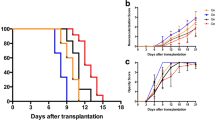Abstract
Background
New insights into the molecular mechanisms of corticosteroid-mediated actions have revealed new substances, such as selective glucocorticoid receptor agonists (SEGRA), for the treatment of inflammatory diseases. We set out to evaluate the effect of a SEGRA compound following topical application on the course of experimental orthotopic corneal grafts.
Methods
A total of 42 female Lewis rats received 3.5-mm MHC I/II-incompatible corneal grafts from DA donors. Recipients were randomly assigned to receive either no therapy, 0.25% cyclodextrin-encapsulated SEGRA compound in a new microemulsion formulation or carrier system only. All treatments started on the day of surgery and were given five times daily for 35 days. Grafts were graded every day and a rejection score was generated based on cornea clarity and edema. In addition, intragraft mRNA expression of CD3, IFN-γ, TNF-α, IL-10 and IL-4 was analyzed using real-time RT-PCR analysis at day 7 after transplantation before rejection occurred in additional control animals.
Results
Topical application of a SEGRA compound was highly effective in prolonging the mean survival time of corneal grafts (42.2±4.0 days) compared with untreated controls (11.7±1.2 days, p=0.00003) or animals that received the vehicle only (15.0±1.5 days, p=0.114). In addition, real-time RT-PCR analysis of SEGRA-treated grafts revealed lower mRNA expression of intragraft cytokines; the difference was significant for IL-4 (p<0.05).
Conclusions
Our results indicate that topical application of a SEGRA compound significantly prolongs corneal graft survival in an experimental keratoplasty model. It further suggests that SEGRA can be a potentially useful drug to suppress the immune response.



Similar content being viewed by others
References
Callanan D, Peeler J, Niederkorn JY (1988) Characteristics of rejection of orthotopic corneal allografts in the rat. Transplantation 45:437–443
Gill TJ, Kunz HW, Misra DN, Hassett ALC (1987) The major histocompatibility complex of the rat. Transplantation 43:773–785
Holland EJ, Chan CC, Wetzig RP, Palestine AG, Nussenblatt RB (1991) Clinical and immunhistological studies of corneal rejection in the rat penetrating keratoplasty model. Cornea 10:374–380
Lütjen-Decroll E, May CA, Polansky JR, Johnson DH, Bleomendal H, Nguyen TD (1998) Localization of the stress proteins alpha B-crystallin and trabecular meshwork inducible glucocorticoid response protein in normal and glaucomatous trabecular meshwork. Invest Ophthalmol Vis Sci 39:517–525
Mantel N (1966) Evaluation of survival data and two new rank order statistics arising in its consideration. Cancer Chemother Rep 50:163–170
Pleyer U (ed) (1996) Immunobiology and prevention of allograft reaction after experimental keratoplasty. Aeolus, Buren, pp 22–23
Pleyer U, Milani JK, Duke A, Chou J, Lutz S, Rückert D, Thiel HJ, Mondino BJ (1995) Effect of topically applied anti-CD4 monoclonal antibodies on orthotopic corneal allograft in a rat model. Invest Ophthalmol Vis Sci 35:52–61
Pleyer U, Milani JK, Rückert D, Rieck P, Mondino BJ (1997) Determinations of serum tumor necrosis factor alpha in corneal allografts. Ocul Immunol Inflamm 5:149–155
Pleyer U, Bertelmann E, Rieck P, Hartmann C, Volk HD, Ritter T (2000) Survival of corneal allografts following adenovirus-mediated gene transfer of interleukin-4. Graefes Arch Clin Exp Ophthalmol 238:531–536
Reichardt HM, Tronche F, Berger S, Kellendonk C, Schütz G (2000) A new insights into GC and mineralocorticoid signaling: lessons from gene targeting. Adv Pharmacol 47:1–21
Sano Y, Osawa H, Sotozono C, Kinoshita S (1998) Cytokine expression during orthotopic corneal allograft rejection in mice. Invest Ophthalmol Vis Sci 39:1953–1957
Schäcke H et al (2002) SEGRAs: a novel class of antiinflammatory compounds. In: Cato A, Schäcke H, Asadullah K (eds) Recent advances in glucocorticoid receptor action. Ernst Schering Research Foundation Workshop. Springer, Berlin Heidelberg New York
Schäcke H, Döcke WD, Asadullah K (2002) Mechanisms involved in the side effects of glucocorticoids. Pharmacol Ther 96:23–43
Sherif Z, Pleyer U (2002) Corticosteroids in ophthalmology: past—present—future. Ophthalmologica 216:305–315
Torres PF, de Vos AF, van der Gaag R, Martins B, Kijlstra A (1996) Cytokine mRNA expression during experimental corneal allograft rejection. Exp Eye Res 63:453–461
Torres PF, de Vos AF, Martins B, Kijlstra A (1999) Interleukin 10 treatment does not prolong experimental corneal allograft survival. Ophthalmic Res 31:297–303
Yamagami S, Kawashima H, Endo H, Tsuru T, Shibui H, Kagawa Y, Hori J, Yamagami H, Isobe M (1998) Cytokine profiles of aqueous humor and graft in orthotopic mouse corneal transplantation. Transplantation 66:1504–1510
Zhang EP, Schulte F, Bulfone-Paus S, Hoffmann F (2000) The effect of corticosteroid and cyclosporin A on murine corneal allograft rejection. Graefes Arch Clin Exp Ophthalmol 238:525–530
Author information
Authors and Affiliations
Corresponding author
Rights and permissions
About this article
Cite this article
Pleyer, U., Yang, J., Knapp, S. et al. Effects of a selective glucocorticoid receptor agonist on experimental keratoplasty. Graefe's Arch Clin Exp Ophthalmol 243, 450–455 (2005). https://doi.org/10.1007/s00417-004-0991-y
Received:
Revised:
Accepted:
Published:
Issue Date:
DOI: https://doi.org/10.1007/s00417-004-0991-y




